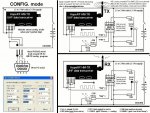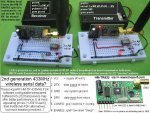I see Microzed are soon going to be stocking the Hope modules. http://www.microzed.com.au/Rf433.htm
I had a play with these and they have real potential. One big advantage is that what goes in one end comes out the other end. With raw RF modules, when they are talking in=out, but when the transmitter is off, the receiver is getting noise. So then you need to filter the noise somehow, usually with a front end picaxe. Using the Hope modules, the data is clean enough to run into a uart.
Also, another advantage is the antenna screws in. With raw modules, you need to measure a bit of wire and get it right to the nearest milimetre. Not hugely hard, but a proper antenna does look neater too.
I got 200 metres out of those modules on a range test. But manuka wanted his samples back so I wasn't able to put them into the project I was building.
Microzed are quick suppliers too - order it and it arrives the next day by express post!
I had a play with these and they have real potential. One big advantage is that what goes in one end comes out the other end. With raw RF modules, when they are talking in=out, but when the transmitter is off, the receiver is getting noise. So then you need to filter the noise somehow, usually with a front end picaxe. Using the Hope modules, the data is clean enough to run into a uart.
Also, another advantage is the antenna screws in. With raw modules, you need to measure a bit of wire and get it right to the nearest milimetre. Not hugely hard, but a proper antenna does look neater too.
I got 200 metres out of those modules on a range test. But manuka wanted his samples back so I wasn't able to put them into the project I was building.
Microzed are quick suppliers too - order it and it arrives the next day by express post!


